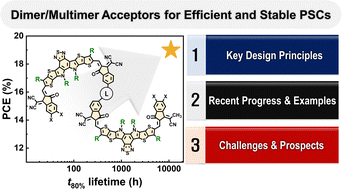Recent progress and prospects of dimer and multimer acceptors for efficient and stable polymer solar cells
Abstract
High power conversion efficiency (PCE) and long-term stability are essential prerequisites for the commercialization of polymer solar cells (PSCs). Small-molecule acceptors (SMAs) are core materials that have led to recent, rapid increases in the PCEs of the PSCs. However, a critical limitation of the resulting PSCs is their poor long-term stability. Blend morphology degradation from rapid diffusion of SMAs with low glass transition temperatures (Tgs) is considered the main cause of the poor long-term stability of the PSCs. The recent emergence of oligomerized SMAs (OSMAs), composed of two or more repeating SMA units (i.e., dimerized and trimerized SMAs), has shown great promise in overcoming these challenges. This innovation in material design has enabled OSMA-based PSCs to reach impressive PCEs near 19% and exceptional long-term stability. In this review, we summarize the evolution of OSMAs, including their research background and recent progress in molecular design. In particular, we discuss the mechanisms for high PCE and stability of OSMA-based PSCs and suggest useful design guidelines for high-performance OSMAs. Furthermore, we reflect on the existing hurdles and future directions for OSMA materials towards achieving commercially viable PSCs with high PCEs and operational stabilities.

- This article is part of the themed collection: Celebrating the scientific accomplishments of RSC Fellows


 Please wait while we load your content...
Please wait while we load your content...